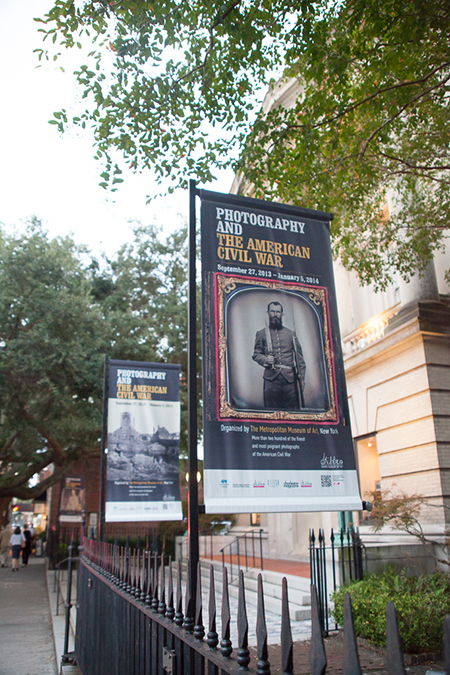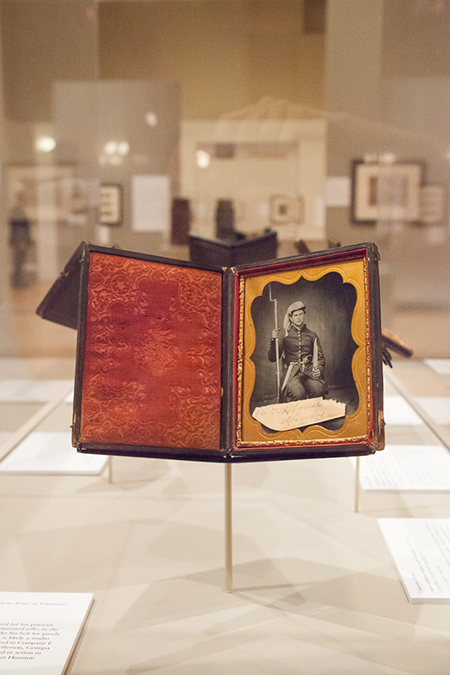When it was announced that the Gibbes Museum of Art would be a part of The Metropolitan Museum of Art’s blockbuster Photography and the American Civil War traveling exhibition tour, I was both excited and apprehensive. You see, I work in the museum’s Retail and Visitor Services department, and I knew I must be prepared for a range of questions, opinions, stories, and emotions from museum visitors.
As many of you know, the “War Between the States” began in our lovely city of Charleston, South Carolina one hundred and fifty years ago. I grew up in South Carolina and saw how aspects of the Civil War affected people’s perceptions and memories, and of course, their ideas on what it means to be patriotic. Despite all of my “education,” I didn’t understand the depth of the Civil War until this exhibition.

The exhibition banners appeared outside of the Museum in the middle of September to advertise the exhibition, and visitors came ‘a-running.’ We had over one hundred people those few weeks before the opening vying to get sneak peaks, tours, and admission into the museum to see the Civil War photographs. When opening day finally arrived and over three hundred people came into the museum, I was elated (and exhausted)! Jeff Rosenheim (Chief Curator of the Department of Photography at the Metropolitan Museum) gave thorough training to docents and staff, but he couldn’t prepare me for the emotional toll of the exhibition that is visible on the faces of our visitors.
Many visitors come downstairs into the museum store with tears in their eyes. Others rush up to the Visitor Services counter and simply say “Wow! That was so powerful.” Even after seeing over two hundred and twenty photographs, many take the extra time in the Museum Store to look carefully at the accompanying catalog written by curator Jeff Rosenheim to further examine the impact of the war. They also will share a story or a memory from their own family about the Civil War. Many families still have diaries, uniforms, or even photographs of their ancestors from the 1860’s. In fact, many of the pieces in the exhibition came from private lenders who for years have carefully maintained these pieces of history.

The physicality of the exhibition, from the stark black and white portraits, to jewelry made from small daguerreotypes, and propaganda posters from the era, strikes a chord in our viewers, and seems to draw memories from their own distant past. Our comment book reflects the emotional impact of the exhibition. One viewer writes, “This is one of the most moving exhibits I have ever seen! I’ve seen these photos in books, but to see the actual photographs made me unexpectedly emotional.”
What this exhibition has repeatedly shown me, through working at the Visitor Services department, is the power of photography. As cliché as it sounds, I didn’t fully realize how many people were affected by the Civil War until I saw the photographs. Photography was only approximately 25 years old at the start of the Civil War, and it was immediately embraced by soldiers and their families. The small portraits were inexpensive and allowed Confederate and Union soldiers a tangible source of pride, self-awareness, and property throughout the horrible experience of war. The families of soldiers were able to send photos in the letters they wrote to their loved ones. Surgeons and medical teams were able to document certain injuries and improve their medical practices through photographs.

The museum has welcomed over 14,000 visitors from September 27th to December 29th and only a few days remain to see this stunning collection. I feel immense pride in seeing these numbers grow throughout the last three months, knowing that the public is coming to the museum to view an important exhibition that documents the Civil War and its impact not only on Charleston’s history, but America’s history as well. The next stop for this traveling exhibition is the New Orleans Museum of Art. I can only hope they are prepared for an emotional rollercoaster of an exhibition!
—Maggie Jordan, Visitor Services and Retail Assistant
Published December 31, 2013

